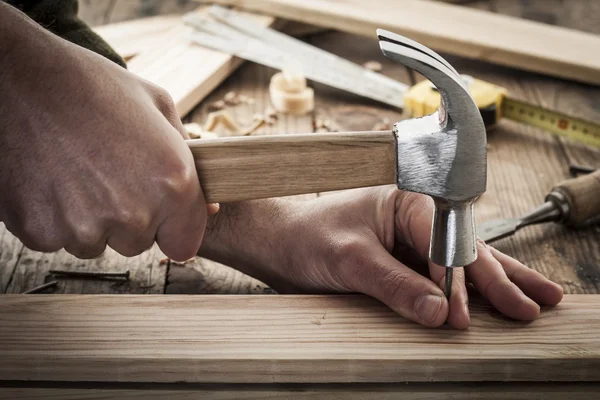Mastering the Use of a Box Nail: A Comprehensive Guide
Box nails with their slender design and smooth shank, have become a staple in woodworking and construction for various applications. These unassuming fasteners offer a wide range of uses, thanks to their clean appearance and reduced risk of wood splitting during installation. Let’s delve into the diverse applications of box nails and how they play a crucial role in both functional and decorative projects. We will also provide a step-by-step guide on how to use a box nail effectively and efficiently to ensure a fine finish.
If you need help finding box nails for any of the versatile applications listed below, see our product review article here.
Exploring the Versatile Applications of a Box Nail: From Finishing Touches to Craftsmanship
Finish Carpentry
One of the primary applications of box nails is in finish carpentry. Their small diameter and smooth shank make them perfect for securing trim, molding, baseboards, and other decorative elements. Whether you’re adding crown molding to a room or installing chair rails, box nails are the go-to choice for a clean and polished finish.
Picture Hanging
When it comes to hanging pictures and artwork, box nails shine. The smaller size of box nails means they create a subtle hole in the wall, minimizing damage to delicate surfaces. Their flat or slightly rounded heads hold pictures securely without drawing attention away from the artwork itself.
Cabinet Making and Furniture Assembly
Box nails are well-suited for cabinet making and assembling furniture. Their unobtrusive appearance ensures that the focus remains on the craftsmanship, while their reliable hold ensures stability in the final product.
Crafts and DIY Projects
From building small wooden boxes to crafting intricate DIY projects, box nails are a versatile choice. They are excellent for joining small wooden pieces and can handle delicate materials without causing damage.
Interior Trim Work
Installing interior trim elements, such as door casings, window trim, and baseboards, requires precision and a clean finish. Box nails excel in this area, providing secure attachment without marring the appearance of the trim.
Restorations and Repairs
When restoring antique furniture or performing delicate repairs on woodwork, box nails offer a delicate touch. Their subtle appearance ensures that the restoration work remains seamless and authentic.
Light Framing and General Carpentry
While box nails are not intended for heavy framing or load-bearing structures, they can be used for light framing and general carpentry where appearance is essential. They are suitable for small-scale framing projects or when a smaller hole is preferred.
Decorative Woodworking
Box nails are frequently employed in decorative woodworking projects, such as crafting wooden picture frames or assembling intricate designs. Their neat and flush finish adds to the overall aesthetic appeal of the final product.
Fastening Thin Wood
Due to their reduced diameter and smooth shank, box nails are less likely to split thin pieces of wood. They are an excellent choice for fastening thin boards and veneers without compromising the material.
Architectural Details
In architectural projects, box nails come into play for attaching delicate architectural details and ornaments. They offer a secure hold without detracting from the overall design.
In conclusion, box nails are a versatile and valuable tool in the world of woodworking and construction. Their slender profile, smooth shank, and clean appearance make them suitable for an array of projects, from finish carpentry to crafts and DIY endeavors. Whether you’re working on a professional construction site or tackling a personal creative project, box nails are a reliable and indispensable fastening solution, elevating the beauty and functionality of your creations.
Step-By-Step Guide on How to Use a Box Nail Effectively and Efficiently to Ensure a Fine Finish
Using a box nail effectively and efficiently is crucial to achieving a fine finish in your woodworking or construction projects. Follow this step-by-step guide to master the art of using box nails and create seamless, professional results.
Step 1: Gather Your Materials
- Box nails of the appropriate size for your project.
- Hammer or nail gun (if using a nail gun, make sure it is compatible with box nails). To read more about hammers, see our hammers’ section here.
- Measuring tape or ruler (for precise measurements).
Step 2: Select the Right Size and Type of Box Nail
Choose the box nails that are suitable for your project. Consider the material, size, and application to ensure they match your specific needs.
Step 3: Prepare the Work Area
Ensure your work surface is clean and free of debris. If you are nailing into wood, pre-drill pilot holes to reduce the risk of splitting, especially near the edges of the wood.
Step 4: Position the Nail
Hold the box nail at a slight angle to the surface, with the head of the nail facing the desired direction. Position the nail where you want it to go, making sure it is perpendicular to the surface.
Step 5: Drive the Nail
Using a hammer or nail gun, gently tap the nail into the surface. Avoid hitting the nail with excessive force, as this can cause it to bend or split the wood. If using a nail gun, ensure you apply consistent pressure to avoid misfires.
Step 6: Sink the Nail
Drive the nail until the head is slightly below the surface of the material. Be careful not to drive it too deep, as this may weaken the hold and mar the surface.
Step 7: Repeat as Necessary
Continue driving box nails into the desired locations, ensuring they are evenly spaced and aligned. Take your time to maintain a consistent and professional appearance.
Step 8: Check for Flushness
Once all the nails are in place, use a nail set or a punch to gently tap any raised nail heads below the surface of the material. This step ensures a flush finish, leaving the surface smooth and ready for further finishing.
Step 9: Fill Nail Holes (If Necessary)
If you prefer a completely seamless finish, you can use wood filler to fill the nail holes. Choose a filler that matches the color of the wood and follow the manufacturer’s instructions for application.
Step 10: Sand and Finish
After the filler has dried, sand the surface to achieve a smooth and even finish. Apply your desired finish, such as paint, stain, or varnish, to complete the project.
Step 11: Clean Up
Clean your work area and tools, and store them properly for future use.
By following these steps, you can use box nails effectively and efficiently, achieving a fine finish in your woodworking or construction projects. Practice and patience will help you master the technique, ensuring that your creations boast a professional and polished appearance.
Frequently Asked Questions
Why is it called a box nail?
The term “box nail” comes from the way these nails were historically packaged and sold. In the past, nails were commonly sold in wooden boxes or containers, and the name “box nail” originated from this packaging practice.
Box nails are a specific type of nail characterized by their slender design, rectangular cross-section, and smooth shank. They are typically smaller in diameter compared to other types of nails with the same length. The reduced diameter helps minimize the risk of wood splitting during installation, making them ideal for delicate or thin pieces of wood.
Over time, the name “box nail” became associated with this particular style of nail, regardless of how they are sold today. While modern nails are now typically sold in plastic bags or other types of packaging, the name “box nail” has endured as a standard term in the industry to describe this specific type of nail.
The term “box nail” helps differentiate this type of nail from other nail varieties, such as common nails, finishing nails, or spiral nails, which have different features and applications. Despite the shift away from wooden boxes for packaging, the name has become firmly established in the world of woodworking and construction, serving as a reference to this unique and versatile type of nail.
What is a box nail made of?
Box nails are typically made from steel, which is a widely used and versatile material for nails due to its strength and durability. The steel used for making box nails can be plain carbon steel or alloy steel, depending on the specific requirements of the nail.
- Plain Carbon Steel: Box nails made from plain carbon steel are cost-effective and commonly used for general applications. This type of steel contains a low percentage of carbon, which provides adequate strength and hardness for most woodworking and construction tasks.
- Alloy Steel: Box nails made from alloy steel contain additional elements such as chromium, nickel, or molybdenum. These alloying elements enhance the properties of the steel, providing increased strength, corrosion resistance, and other desirable characteristics. Alloy steel box nails are often used for specialized applications or in environments where greater durability is required, such as outdoor or high-moisture settings.
Surface Coatings: To enhance the nail’s performance and protection against corrosion, box nails are often coated with various surface finishes. The most common surface coatings include:
- Galvanized: Galvanized box nails have a zinc coating applied to the surface. This coating provides excellent corrosion resistance, making them suitable for outdoor or high-humidity applications. Galvanized box nails are commonly used in construction and carpentry projects where durability is essential.
- Stainless Steel: Box nails made from stainless steel offer superior corrosion resistance due to their high chromium content. Stainless steel box nails are highly recommended for outdoor and marine applications or when working with treated lumber, as they resist rust and discoloration.
- Bright Finish: Some box nails have a bright finish, which is the natural color of the steel without any additional coatings. Bright finish box nails are commonly used for interior applications where corrosion resistance is not a primary concern, and a clean, uncoated appearance is desired.
In summary, box nails are predominantly made from steel, with options for plain carbon steel or alloy steel. The choice of steel and surface coatings depends on the specific application, environmental conditions, and desired durability of the nail. Selecting the appropriate box nail material and coating ensures that your woodworking and construction projects benefit from reliable and long-lasting fasteners.
What is the rule of thumb for box nail length?
The rule of thumb for box nail length is to use a nail that is approximately three times the thickness of the material you are nailing into. This guideline helps ensure that the box nail provides sufficient holding power and securely fastens the material without protruding too far or causing damage.
For example:
- If you are nailing thin material that is 1/4 inch thick, a box nail around 3/4 inch long would be appropriate.
- For 1-inch thick material, consider using box nails around 3 inches long.
However, it’s important to note that the rule of thumb is a general guideline and may not always be applicable to every situation. Factors such as the density of the wood, the type of material, and the specific application may require adjustments to the nail length.
When in doubt, it’s a good idea to test the nail length on a scrap piece of the same material before nailing the actual workpiece. This way, you can ensure that the nails penetrate the material adequately without going too deep or coming out the other side.
Also, keep in mind that the rule of thumb primarily applies to finish carpentry and non-structural applications. For heavy-duty construction and load-bearing tasks, it’s best to follow the manufacturer’s guidelines or consult with a professional for the appropriate nail length and type.
How do you remove a box nail?
Removing a box nail can be done using several methods, depending on the tools and materials you have available. Here are some common approaches to safely and effectively remove a box nail:
Method 1: Prying with a Claw Hammer (if you want to read more about claw hammers, see our product review and guide here):
- Position the claw end of a claw hammer under the nail head, making sure it is firmly wedged beneath the nail.
- Apply pressure to the hammer’s handle to lift the nail out of the wood.
- Wiggle the hammer gently from side to side while applying upward pressure to ease the nail out. Be cautious not to damage the wood surface during this process.
Method 2: Prying with a Nail Puller:
- A nail puller, also known as a cat’s paw, is a specialized tool designed for nail removal.
- Position the nail puller’s V-shaped notch under the nail head and slide it down the shank until it is securely hooked.
- Apply upward pressure on the nail puller’s handle to lift the nail out of the wood.
Method 3: Leveraging with a Crowbar or Pry Bar:
- Place the flat end of a crowbar or pry bar under the nail head, ensuring it is firmly positioned.
- Apply leverage by pushing down on the pry bar’s handle to lift the nail out.
- If necessary, use a block of wood as a fulcrum to increase leverage and ease the nail out.
Method 4: Cutting or Nipping the Nail:
- If the nail is flush with the wood surface or cannot be accessed easily, you can use a pair of pliers or nail nippers to grip the exposed portion of the nail.
- Twist and rock the pliers or nippers back and forth to break the nail off or to loosen it from the wood.
- Once the nail is loosened, use the pliers or nippers to pull the nail out completely.
Method 5: Using a Nail Set:
- If the nail head is slightly protruding from the surface, you can use a nail set and a hammer to drive the nail back into the wood.
- Place the nail set on the nail head and tap it gently with a hammer to drive the nail below the wood surface.
- After the nail is recessed, you can fill the hole with wood filler or putty to conceal it.
When removing box nails, work carefully to avoid damaging the surrounding wood surface. If you encounter resistance while removing the nail, stop and reassess your approach to prevent causing further damage. Additionally, wear appropriate safety gear, such as safety goggles, to protect your eyes from flying debris during the nail removal process.
editor's pick
news via inbox
Stay one step ahead with exclusive tips, guides, and offers delivered directly to your inbox.
Sign up for our newsletter and elevate your home improvement game today!


